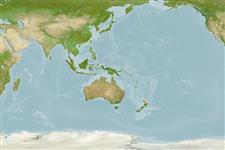Environment: milieu / climate zone / depth range / distribution range
Ecologie
marien; brak water rifbewoner; diepte 1 - 30 m (Ref. 34095). Subtropical; 25°S - 38°S
Western Pacific: Queensland to Victoria, Australia.
Grootte / Gewicht / Leeftijd
Maturity: Lm ? range ? - ? cm
Max length : 15.0 cm TL mannelijk / geslacht onbekend; (Ref. 4690)
Dorsale stekels (totaal) : 15 - 16; Dorsale zachte stralen (totaal) : 7 - 9; Anale stekels: 3; Anale zachte stralen: 5; Wervels: 26 - 27. Presence of a large horizontal spine below the eye, a dorsal fin which originates just behind the posterior edge of the eye, and venomous dorsal spines.
Found in seagrass beds in estuaries (extremely common during reproductive season in the austral Spring) and coastal bays, and sponge gardens on inshore reefs. Venomous dorsal spines often inflict a painful sting to fishers (Ref. 34095, 39597). Of no commercial importance but often entrapped in fishing gears such as trawls and can be dangerous to fishermen who attempt to remove these (Ref. 39597).
Levenscyclus en paargedrag
Maturities | Voortplanting | Spawnings | Egg(s) | Fecundities | Larven
Paxton, J.R., D.F. Hoese, G.R. Allen and J.E. Hanley, 1989. Pisces. Petromyzontidae to Carangidae. Zoological Catalogue of Australia, Vol. 7. Australian Government Publishing Service, Canberra, 665 p. (Ref. 7300)
Status op de Rode Lijst van het IUCN (Ref. 130435)
Gebruik door de mens
Tools
Speciale rapporten
Download XML
Internetbronnen
Estimates based on models
Preferred temperature (Ref.
123201): 17.6 - 24.2, mean 20.7 °C (based on 105 cells).
Fylogenetische diversiteitsindex (Ref.
82804): PD
50 = 0.6250 [Uniqueness, from 0.5 = low to 2.0 = high].
Bayesian length-weight: a=0.01122 (0.00514 - 0.02450), b=3.04 (2.87 - 3.21), in cm total length, based on all LWR estimates for this body shape (Ref.
93245).
Trofisch niveau (Ref.
69278): 3.2 ±0.3 se; based on size and trophs of closest relatives
Weerstandsvermogen (Ref.
120179): Gemiddeld, minimale populatieverdubbelingstijd 1,4-4,4 jaar (Preliminary K or Fecundity.).
Fishing Vulnerability (Ref.
59153): Low vulnerability (10 of 100).
Nutrients (Ref.
124155): Calcium = 51.7 [17.2, 144.7] mg/100g; Iron = 0.661 [0.315, 1.457] mg/100g; Protein = 18.7 [17.1, 20.2] %; Omega3 = 0.348 [0.142, 0.957] g/100g; Selenium = 10.4 [4.3, 25.7] μg/100g; VitaminA = 104 [31, 354] μg/100g; Zinc = 1.37 [0.86, 2.17] mg/100g (wet weight);
